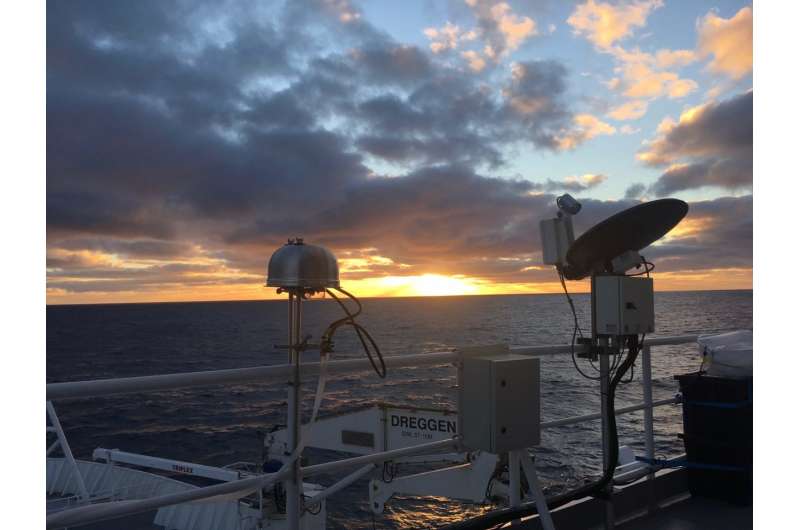Researchers fly and sail to stormiest place on Earth to study cloud processes

By ship and by plane, Department of Atmospheric Science researchers ventured to the stormiest place on Earth, the Southern Ocean, to collect cloud, aerosol and precipitation data for a project called SOCRATES. Knowledge gained during the Southern Ocean Clouds, Radiation, Aerosol Transport Experimental Study is expected to enhance weather and climate modeling and forecasting capabilities across the globe.
Data collection
Graduate student Kathryn Moore, stationed aboard the research vessel RV Investigator, collected data and samples to document primary ice nucleation and its influence on cloud phase. Primary ice nucleation is the formation of the first ice crystals in a cloud, which usually occurs on atmospheric aerosol particles known as ice nucleating particles. Cloud phase is the state of the cloud, liquid or ice.
"The SOCRATES project was designed to collect samples and observations to provide new datasets and parameterizations with which to test and improve weather and climate models," Moore explained.
Hands-on data collection was necessary to advance understanding of cloud formation over the Southern Ocean because current assessment is based almost entirely on satellite observations. This gap in knowledge leads to inaccurate climate models.
"The Southern Ocean is one of the most remote regions on Earth, far from anthropogenic and terrestrial aerosol sources, and so it is an ideal place to study natural aerosols and their interactions with clouds and radiation," Moore said.
A multinational campaign
CSU's team of scientists had instruments aboard both the RV Investigator, an Australian Marine National Facility research vessel, and HIAPER, or the High-performance Instrumented Airborne Platform for Environmental Research. HIAPER is a highly modified Gulfstream V jet that is owned by the National Science Foundation and operated by the National Center for Atmospheric Research in Boulder (NCAR). The project is a collaboration among U.S. universities and Australian scientists, with the U.S. portion funded by the NSF and supported by NCAR.
"It was truly a multinational campaign," said Senior Research Scientist Paul DeMott, who led the group from CSU. "Our team's role was to collect data that ultimately helps explain errors in global climate model predictions of solar radiation reaching the ocean surface."
Findings
Ice nucleating particles are suspended in the atmosphere and provide the foundation for the most common method of ice formation in the atmosphere. Though the ice nucleating particles are very rare, they have strong control over the liquid or ice phases of a cloud. Once a cloud has glaciated, or turned from predominantly liquid to ice, its reflective properties and radiative effect change significantly, and it can begin to precipitate as snow or ice, rather than just rain.
DeMott shared flight scientist duties with recent CSU graduate Christina McCluskey, now an NCAR Advanced Study Program postdoctoral fellow. DeMott and McCluskey utilized two methods for assessing ice nucleating particle concentrations and a bioaerosol detector while flying over the Southern Ocean, just as Moore was collecting similar samples using the same methods at sea level, along with water samples.
"As expected, the concentrations of ice nucleating particles over the Southern Ocean were some of the lowest on Earth, both in the marine boundary layer at the surface and higher up in the troposphere," Moore said.
Still, the extraordinarily low numbers of the particles in the air were somewhat surprising to DeMott, as were some other discoveries.
"Clouds were also more multilayered than we anticipated, and this has implications for radiative transfer and satellite detection," DeMott said.
Given the broad scope of the expedition and the vast amount of analysis yet to perform, discoveries and definitive conclusions are still on the horizon. However, according to DeMott, the SOCRATES project already has been a success.
"We performed the most comprehensive characterization of Southern Ocean clouds and aerosols yet undertaken, our data sets are rich, and we will be able to answer our major hypotheses."
Provided by Colorado State University

















